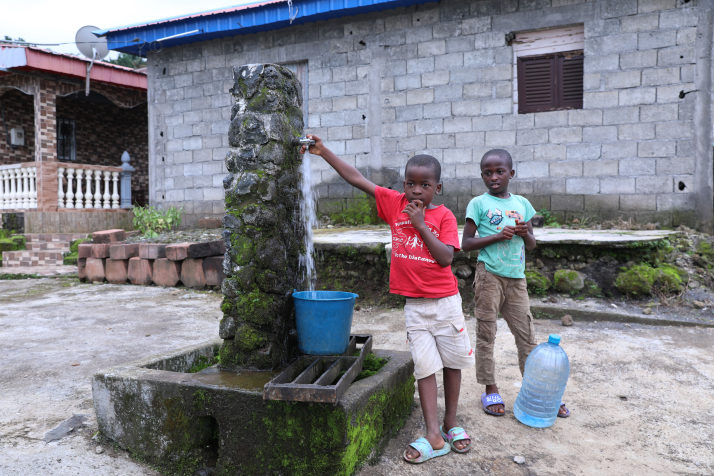| Business |
| How China's state-owned enterprises power the Belt and Road Initiative | |
|
|
 Workers at the construction site of a housing project in Kuwait contracted to two Chinese state-owned enterprises, on August 6 (XINHUA)
An Indonesian coin was balanced on the windowsill of a comprehensive inspection train (CIT) during the testing of the Jakarta-Bandung High-Speed Railway (HSR) on June 22. The coin remained in place even as the train reached its design speed of 350 km per hour for the first time. The test result was strong evidence the railway was close to being ready for service. At this speed, the railway, spanning 142.3 km, will cut the journey between Jakarta, capital of Indonesia, and Bandung, the third largest city in the country, from over three hours to around 40 minutes. The forthcoming HSR, the first of its kind both in Indonesia and in Southeast Asia, has become a hot talking point among local people, who are excited to take high-speed trains in their own country. Infrastructure titans China's state-owned enterprises (SOEs) in a variety of sectors have contributed to turning the HSR from paper into reality. While the CIT and the electric passenger trains to be used on the railway were designed and manufactured by the world's largest supplier of rail transit equipment CRRC Corp. Ltd., the roads, bridges, tunnels and stations alongside the line were also constructed by China Railway Group Ltd., POWERCHINA and China Communications Construction Co. Ltd. (CCCC). "With rich experience and strong technological strength, they are able to offer high-standard design, construction and management to ensure the quality and efficiency of large projects," financial commentator Zhang Xuefeng told Beijing Review. According to the State-Owned Assets Supervision and Administration Commission (SASAC) of the State Council of China, over the past decade, enterprises directly under its supervision, commonly known as centrally administered SOEs, have undertaken more than 200 major overseas projects like ports, railways and airports. Also, the overseas service networks of China's state-owned telecom operators now cover more than 40 countries around the world. As for the energy industry, centrally administered SOEs have contracted to build nearly 300 overseas hydropower, wind power and photovoltaic power projects. The landmark projects include the Karot Hydropower Project in Pakistan and Belo Monte ultra high voltage transmission project in Brazil, which have boosted green and low-carbon development in the host countries. "Over the first 10 years of the Belt and Road Initiative (BRI), the achievements of centrally administered SOEs in giant Belt and Road infrastructure projects are notable as they have brought China's production capacity, technologies and efficiency to other participating countries," Qiu Wenxu, a researcher with the Silk Road Academy of Social Science, told Beijing Review. "The past experience of China's reform and opening up has proven that well-constructed infrastructure is not only a solid foundation for national economic development, but also provides an advantage for countries when promoting foreign trade and investment," Qiu said. The roads, rails, docks and warehousing facilities all lower transportation and storage costs of traded goods and improve efficiency, while infrastructure in energy, telecommunication and housing sectors facilitate networking and lower energy costs, and optimize local business environments, he added.  Children in a village in Equatorial Guinea get water from a public faucet, part of a water project built by a Chinese state-owned enterprise that serves 24 villages and towns in the African country, on June 13 (XINHUA)
Architects of change In addition to giant infrastructure projects, China's SOEs have stepped up efforts to undertake small yet often heartwarming social responsibility projects. In West Africa, the CCCC was committed to building a "Chinese delivery room" for sea turtles. In construction of the new Tema Container Terminal, the largest port project in Ghana, the project team discovered the area around the project is the main habitat of a world-class endangered species of sea turtles and home to five of the world's seven major sea turtle species. To protect the turtles, the company employed experts in related fields, purchased advanced instruments and created a dynamic system for sea turtle protection. The hatching rate of sea turtle eggs has improved from 10 to 20 percent under natural conditions to 80 percent in the China-built facility. In Brazil, the Brazilian subsidiary of China's State Grid Corp., the world's largest utility company, has been sponsoring the Mare Orchestra of Tomorrow, a social project in one of Rio de Janeiro's most violent shantytowns. The orchestra's director Carlos Eduardo Prazeres said music can make miracles happen among those living in crime-ridden areas. These miracles are now beginning to occur as the children of the impoverished community are changing their destinies by participating in the program. Peng Huagang, Secretary General of the SASAC, said centrally administered SOEs uphold the principle of high-quality development while advancing their international businesses. They pursue sustainable and common development. While bringing Chinese products, technologies and standards to other countries, they also introduce China's culture and development experiences to local people. Social projects not only drive the development of host regions, but also bring locals job opportunities in a more direct manner, boost the service industry and enhance people-to-people ties, according to Qiu. "Social projects are of strategic importance to the Belt and Road cooperation," Zhang said. "Given the diversity of BRI participating countries and their varied demands for development, large infrastructure projects alone cannot meet the requirements of all partners." The small projects underscore sustainable development, technological innovation and regional collaboration, which are conducive to improving local economic structure and enhancing their capacity for self-development, he added. (Print Edition: Beyond Bridges and Roads) Copyedited by G.P. Wilson Comments to zhangshsh@cicgamericas.com |
|
||||||||||||||||||||||||||||||
|